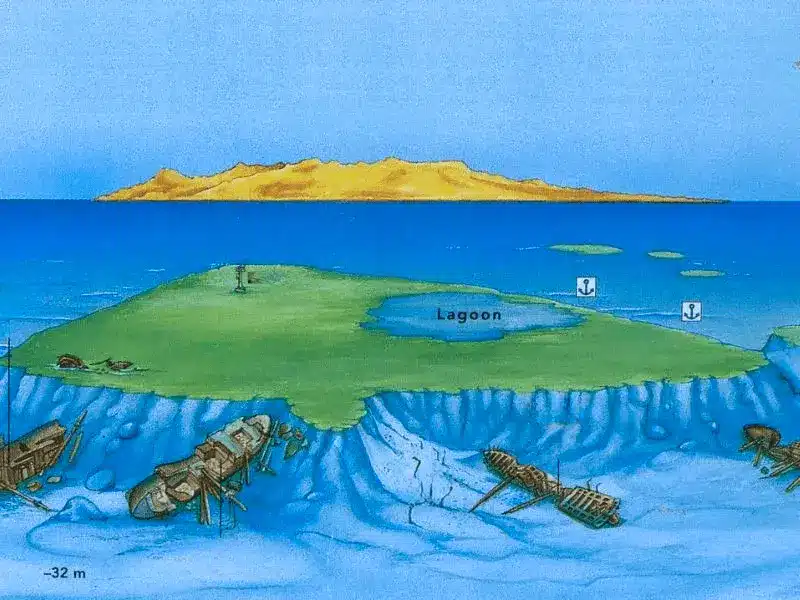The Red Sea is a treasure trove of history and marine beauty, offering divers an unparalleled opportunity to explore some of the world’s most iconic shipwrecks.
From wartime cargo ships to ancient trading vessels, these underwater relics tell stories of adventure, tragedy, and survival.
In this post, we’ll dive into the fascinating history behind these wrecks and share tips on how to explore them safely.
The Legendary SS Thistlegorm
The SS Thistlegorm is arguably the most famous wreck in the Red Sea. This British cargo ship sank during World War II in 1941 after being bombed by German aircraft.
Located near Ras Mohammed National Park, the wreck lies at a depth of 30 meters and has become a must-visit site for advanced divers.

What Makes It Unique? The SS Thistlegorm’s cargo remains remarkably intact, giving divers a glimpse into history.
You’ll find motorcycles, trucks, ammunition, and even railway carriages scattered within its holds. Exploring this wreck feels like stepping back in time to World War II.
Diving Tips:
- Due to its depth and currents, the SS Thistlegorm is recommended for advanced divers.
- Plan your dive early in the day to avoid crowds.
- Consider hiring a guide to navigate its intricate structure safely.
The Ghosts of Abu Nuhas: A Collection of Wrecks
Known as the “Ship Graveyard,” Abu Nuhas is home to several wrecks that have claimed their place in history.
Located near the Straits of Gubal, this reef is infamous for causing numerous shipwrecks due to its shallow, treacherous waters.
Here are the key wrecks you can explore:

The Carnatic
The Carnatic, a British steamship, sank in 1869 while carrying wine, cotton, and gold. It now lies at a depth of 20–27 meters, encrusted with coral and teeming with marine life.
Highlights:
- Stunning coral formations covering the wreck.
- Schools of glassfish and vibrant soft corals make it a photographer’s dream.
The Chrisoula K (“Tile Wreck”)
Sinking in 1981, the Chrisoula K earned its nickname due to its cargo of Italian tiles. The wreck is a popular site for intermediate divers, lying at a depth of 25 meters.
Highlights:
- Large, open holds that allow for easy exploration.
- Perfect for spotting lionfish and moray eels.
The Kimon M (“Lentil Wreck”)
The Kimon M sank in 1978 while carrying a cargo of lentils. The ship’s remains rest at a depth of 32 meters, making it a site best suited for experienced divers.
Highlights:
- Sloping wreck structure covered in marine growth.
- Frequent sightings of groupers and barracudas.
The Giannis D
The Giannis D, a Greek cargo ship, sank in 1983 and is one of the most photographed wrecks in the Red Sea. Its broken structure lies between 10 and 24 meters deep, making it accessible to divers of various skill levels.
Highlights:
- The engine room is a favorite spot for exploration.
- Home to vibrant marine life, including nudibranchs and schools of fish.
The Salem Express: A Somber Memorial
The Salem Express is one of the Red Sea’s most controversial wrecks due to its tragic history.
This ferry sank in 1991 after hitting a reef near Safaga, resulting in the loss of hundreds of lives. The wreck lies at a depth of 12–30 meters.

What Makes It Unique? Unlike other wrecks, the Salem Express serves as a somber reminder of human fragility. Divers often approach the site with reverence, avoiding penetration into its interior out of respect for those who perished.
Diving Tips:
- The shallow depth makes it accessible to divers of all levels.
- Be mindful of the site’s sensitive history and dive respectfully.
Tips for Wreck Diving in the Red Sea
Wreck diving is an exciting yet challenging activity. To make the most of your experience, follow these tips:
- Get Certified: Most wreck dives require Advanced certification. Ensure you have the necessary skills and experience.
- Use Proper Equipment: A dive light, gloves, and a reliable dive computer are essential.
- Dive with a Buddy: Wrecks can be complex to navigate. Always dive with a partner or guide.
- Respect the Wrecks: Avoid touching or removing artifacts. These sites are both historical and ecological treasures.
Plan Your Next Red Sea Wreck Diving Adventure
The Red Sea’s wrecks offer a unique blend of history, mystery, and marine beauty.
Whether you’re exploring the wartime relics of the SS Thistlegorm or the coral-covered remains at Abu Nuhas, these dives promise unforgettable experiences.
Ready to dive into history? Book your next adventure with Extra Fun Diving Club.
Visit our Wreck Diving Tours page to learn more and start planning today!
Discover the secrets beneath the waves and make memories that last a lifetime. The Red Sea’s wrecks are calling!





Comment (0)